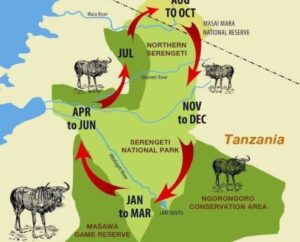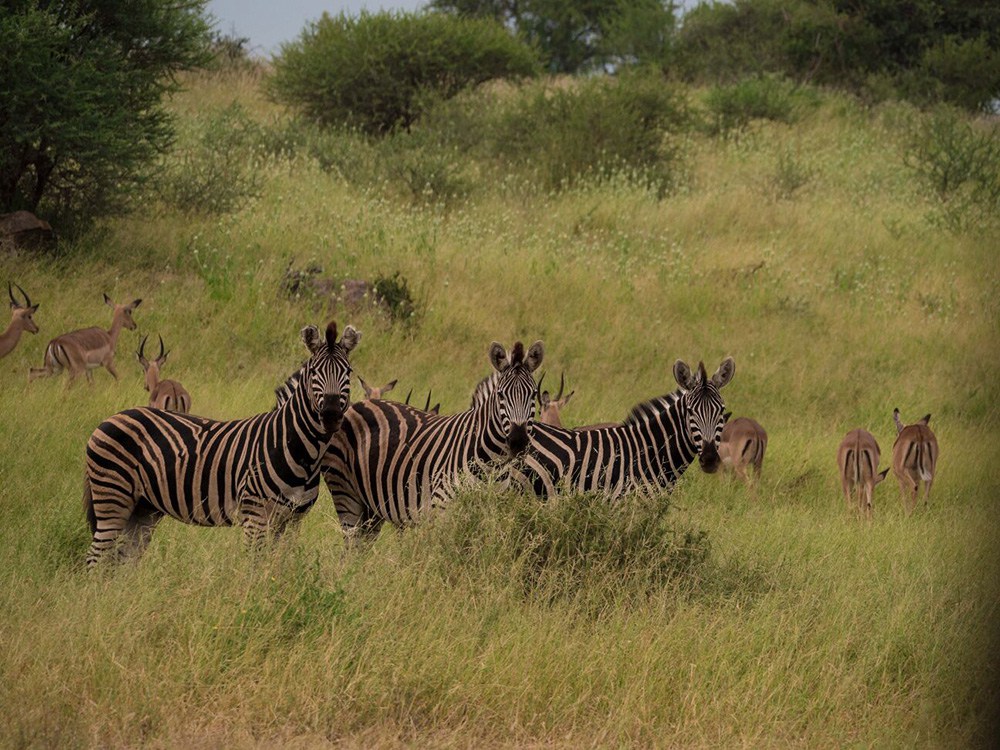Most people think that the Wildebeest Migration only takes place between June and October, but it is a year-round occurrence. There are various but equally exciting events that occur at different times of the year. The river crossings usually coincide with safari high season so consequently, there is a perception that it is the only time of the year that the wildebeest migrate or can be seen.
What is the Great Migration?
The migration occurs within an area that is known as the Serengeti ecosystem. It is not a single isolated event. Instead, the phrase describes the constant movement of over 1.5 million wildebeest, hundreds of thousands of zebra, and smaller numbers of antelope. The noisy, grunting army, chomp and trample the grass, rush across the Mara River in search of fresh grazing and provide predators with a season of plenty until the arrival of the short rains in October and November which draws them south to Tanzania again.
The Mara is the most northerly portion of the migration route and is the acclaimed location for the wildebeest migration due to its famed Mara River crossings. It has been named as one of UNESCO’s wonders of the world. This has led to some misunderstandings about the migration: it is an ever-moving column of animals following an age-old route that takes place throughout the year. The purpose of the movement is the search for pasture and water. When these vital resources are depleted in one area the animals move on to the next. Along the way, there is drama as animals are taken by predators but thousands more are born sustaining the circle of life.

When will the Migration Begin?
This is the question asked at every lodge in the Mara, every year. No one knows exactly when but usually by late June early July the “answer” is already tramping across the plains as hundreds of thousands of hoofed animals come together and cross the Serengeti towards the new grass of the Mara.
The precise timing of the Serengeti wildebeest migration is entirely dependent upon rainfall patterns each year. It is unclear how the wildebeest know when or where to go but it is generally believed that their journey is dictated by the weather. There is no way to predict exactly where the animals will be at any given time during their journey.
What triggers them to muster the energy to begin a 1000km round trip through two countries, across plains with lion and leopard waiting for them and the treacherous river crossings with crocodiles? Around 250 000 die along the way, lost to predators, disease, fatigue, starvation, and thirst even when there is still plenty of food around on the rolling plains of the Serengeti. But, somehow, a few seem to sense it is time, perhaps there something in the air, and just like that they get up and go and the largest terrestrial migration of animals on earth begins. Why, when most wildebeest in Africa are non-migratory do the animals in the Mara-Serengeti ecosystem risk so much in one mad trip?
It remains a mystery, but some scientists believe it is to do with the chemistry of the grass. The herds are attracted to higher levels of phosphorous, calcium, and nitrogen which change in response to the rains. So perhaps the animals are just following their taste. It could also possibly be instinct, as for eons the wildebeest have been following this route across the plains of East Africa.

Migration Calendar
Although there is no beginning or end to the migratory circuit it seems reasonable to call the birthing season, around the end of January/early February, the start of the migration. In mid-March, the mothers have calved and thousands appear happy milling around the rolling plains of the Serengeti. The abundance of vulnerable young calves, also means that predators are numerous and hunting is easy.
During April, the herds begin to drift northwest towards the fresher grass of the central Serengeti, bringing thousands of zebra and smaller antelope with them. By May the columns of wildebeest stretch up to 40km and the mating season begins towards the end of the month, with the males battling head-to-head during “the rut” Throughout this time the journey continues at a leisurely pace with the wildebeest, zebra, and gazelles grazing as they go along. In June, the dry season usually begins and by July they have been trekking across the plains for 3 months but still have the final hurdle of the rivers to confront, which are the most dangerous parts of the journey.
At the end of August, most of the animals have faced the challenge of the Mara River crossing and are spread throughout the Mara enjoying the nutrient-rich corn-colored grasses that stand tall enough to hide a prowling lion.
During September and October, the main chaos has ended and the migration gradually moves eastwards. However, the wildebeest must once more prepare to cross the Mara River for their return journey southwards. The plains are bare by the time the wildebeest return south at the end of the dry season with the lush grasses reduced to yellow stubble by millions of mouths and hooves.
During November, the storm clouds gather in the distance, they sniff the air and start heading back to the Serengeti National Park in search of fresh green meadows. By January they have completed the southward trek, with the new grasses lush and inviting in the deep south of the Serengeti and the cycle continues as the calving season begins once again. As if they have no memory of the dangers ahead, they still go year after year on their migration circuit.
 Wilderness Areas and Mass Tourism
Wilderness Areas and Mass Tourism
Despite the development of vaccines, the future is still unclear on when or if the world will return to anything like the past. There are so many questions that need to be addressed. Will the reduced income from tourism lead to the loss of national reserves and parks and an increase in poaching as communities struggle financially? Can natural wilderness areas and wildlife conservation be managed and funded more appropriately rather than from mass tourism?
Hopefully, answers will be found so that our children and grandchildren can also experience the magic of the world’s natural wonders such as the Great Migration.
EcoTraining in Kenya
EcoTraining offers a variety of courses in Kenya and for enthusiastic learners, you can read more about our Kenya Courses on our website.

0 Comments